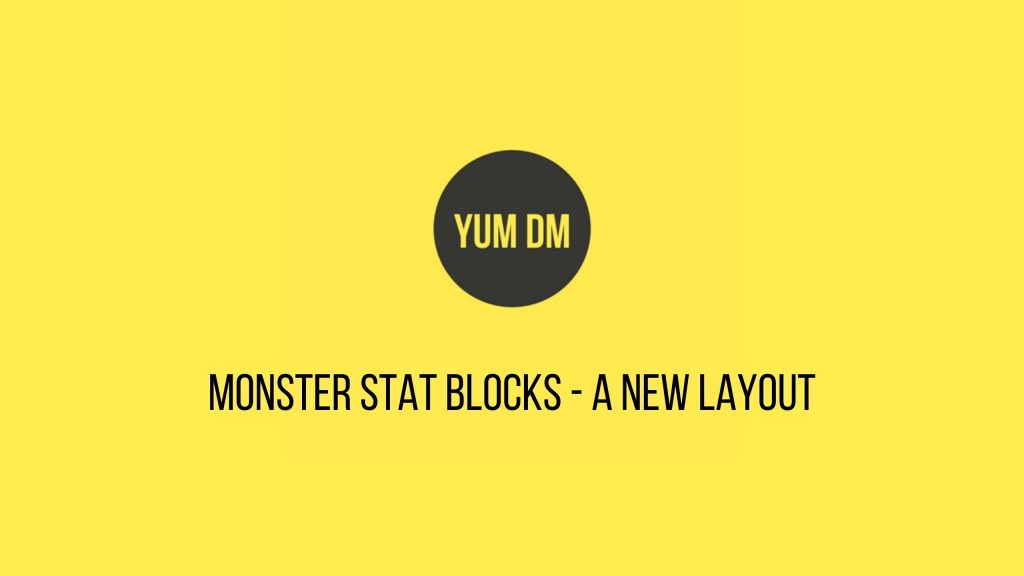
Monster stat blocks are an essential part of the Dungeons & Dragons game.
They let the GM know a lot about the monster – at least they should.
What they tend to end up like is a combat block, rather than a monster stat block, focusing on combat-orientated information.
Helpful in combat, but not very complete, given the characters may want to parley or interact with the creature in other ways.
What I have developed is a modular monster stat block that will give GMs the information they need – at a glance – to run the monster in any situation.
Monster Stat Blocks
What follows is the template I use.
Name
Size & Type
Climate/Terrain
Frequency
Organisation
Activity Cycle
Alignment
Treasure
Advancement
Languages
—
Abilities
Skills
Feats
—
Senses
AC
Immunities/Resistances
Speed
HD/HP
Number Attacks (Damage)
Reach
Special Abilities
Morale
Saves
As you can see, the block is divided into three “modules”.
Non-combat information is listed first to give the GM the ability to see where the monster would appear and whether they would be active.
This information is especially important for building random encounter tables for your campaign world, allowing you see where a creature would be.
If you want to know how to create and use random encounter tables, check out Issue 7 of my free D&D zine.
The second module gives the GM information about the creature’s abilities, skills, and feats (if appropriate).
And finally, the last module focuses on combat. Giving the GM the information he needs to run the creature if a fight breaks out.
Breakdown of Monster Stat Blocks
Module One
Size & Type – What size the creature is and what type (based on the types listed in the monster manual.
Climate/Terrain – What climate and what terrain the creature is usually found in.
Frequency – How often the creature is found: very rare, rare, uncommon, or common. Use these to fill out your encounter tables.
Organisation – What numbers the creatures appear. This can help you understand how many creatures appear on your encounter tables.
Activity Cycle – Whether they are more active during the day or at night, or both.
Alignment – What alignment they tend to be.
Treasure – What treasure they sually have with them or in their lair.
Advancement – How they advance – either by size/HD or by class.
Languages – What languages they speak.
Module Two
Abilities – The creature’s strength, constitution, dexterity, intelligence, wisdom, and charisma.
Skills – What skills (or proficiencies) the creature has.
Feats – What feats, if any, the creature has.
Module Three
Senses – Special sight, hearing, smell, or other sense the creature may have.
AC – The armour class of the creature
Immunities/Resistances – Any immunities or resistances the creature has.
Speed – How fast/far the creature moves.
HD/HP – Hit dice and hit points of the creature
Number Attacks (Damage) – Various attacks the creature has (and the damaged caused by those attacks).
Reach – How far the creature can strike in combat.
Special Abilities – Any special abilities the creature has.
Morale – The morale score of the creature.
Saves – Any saving throws the creature has.
Example Monster Stat Block
Orc
Size & Type: Medium-sized & Humanoid
Climate/Terrain: Any land and underground
Frequency: Common
Organisation:
Gang (2-4);
Squad (11-20, plus 3rd lvl sergeant, 3rd-6th lvl leader)
Band (30-100, plus 150% non-combatants, plus 3rd lvl sergeant per 10 adults, 5 x 5th lvl lieutenants, 3 x 7th lvl captains)
Activity Cycle: Night
Alignment: Evil
Treasure: Standard
Advancement: By class
Language: Orcish, Common (2 in 6 chance)
—
Abilities: Str 15; Dex 10; Con 11; Int 9; Wis 8; Cha 8
Skills: Awareness +3;
Feats: Alertness
—
Senses: Darkvision 60ft
AC: 14 (+4 Scale Mail)
Immunities/Resistances: None
Speed: 20ft (Scale Mail); Base 30ft
HD/HP: 1 / 5
Number Attacks (Damage):
Great Axe melee +3 (D12+3)
Javelin ranged +1 (D8+2)
Reach: 5ft
Special Abilities: None
Morale: 8 (10 with strong leader)
Saves: Fort +2; Ref +0; Will -1
A Second Example
Griffon
Size & Type: Large-sized & Beast
Climate/Terrain: Temperate and warm hills & mountains
Frequency: Uncommon
Organisation:
Solitary (1);
Pair (2);
Pride (6-10)
Activity Cycle: Day
Alignment: Neutral
Treasure: None
Advancement: By size (11-21 HD Huge)
Language: None
—
Abilities: Str 18; Dex 15; Con 16; Int 5; Wis 13; Cha 8
Skills: Awareness +10; Jump +8
Feats: None
—
Senses: Scent
AC: 17 (+6 Natural; -1 Size; +2 Dex)
Immunities/Resistances: None
Speed: 30ft; Fly 80ft
HD/HP: 7D10+21 / 59
Number Attacks (Damage):
Bite melee +8 (2d6+4)
Claws melee +3 (D4+2)
Full Attack: Bite + 2 x Claws
Reach: 10ft
Special Abilities: Pounce, Rake (D6+2)
Morale: 8
Saves: Fort +8; Ref +7; Will +3
Change What You Need
Of course you could change, delete, or add to the actual entries to suit the edition you play, but the idea remains the same: to focus on more than just combat within your monster stat blocks.
Over to You
What do you think, would you use something like this?
While You’re Here…
Since 2021 I have been publishing a monthly zine, which has a ton of articles for any edition of Dungeons & Dragons.
They are also available on DriveThruRPG and printed copies are available via my Patreon.
I also have a growing Discord, where you can join in on my regular West Marches campaign.
I will also be releasing some more products in the near future, like several monster manuals and a series of soloRPG publications.
Feel free to reach out to me on Twitter any time.
While You’re Here…
Since 2021 I have been publishing d12 Monthly, a monthly zine, which has a ton of articles for any edition of Dungeons and Dragons.
Printed copies are available in my store. The PDF is available on DriveThruRPG and you can get both, plus support my work, via my Patreon.
I will also be releasing some more products in the near future.
Feel free to reach out to me on Twitter or my contact page any time.
